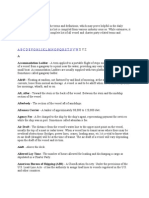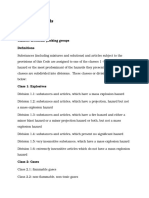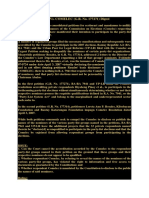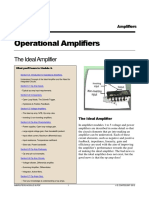0 ratings0% found this document useful (0 votes)
76 viewsFlotation
Flotation
Uploaded by
jeth saganaWhen a ship changes between salt water and fresh water, its draft and displacement change due to differences in water density. As density decreases, draft increases to maintain the same displacement. The increase in draft is called the fresh water allowance (FWA). FWA depends on the ship's displacement and tonnes per centimeter immersion. Linear interpolation can be used to calculate draft changes for any density between salt and fresh water. When a ship floats at the same draft in different densities, its displacement will vary according to the density of the water.
Copyright:
© All Rights Reserved
Available Formats
Download as PPT, PDF, TXT or read online from Scribd
Flotation
Flotation
Uploaded by
jeth sagana0 ratings0% found this document useful (0 votes)
76 views33 pagesWhen a ship changes between salt water and fresh water, its draft and displacement change due to differences in water density. As density decreases, draft increases to maintain the same displacement. The increase in draft is called the fresh water allowance (FWA). FWA depends on the ship's displacement and tonnes per centimeter immersion. Linear interpolation can be used to calculate draft changes for any density between salt and fresh water. When a ship floats at the same draft in different densities, its displacement will vary according to the density of the water.
Original Title
Flotation.ppt
Copyright
© © All Rights Reserved
Available Formats
PPT, PDF, TXT or read online from Scribd
Share this document
Did you find this document useful?
Is this content inappropriate?
When a ship changes between salt water and fresh water, its draft and displacement change due to differences in water density. As density decreases, draft increases to maintain the same displacement. The increase in draft is called the fresh water allowance (FWA). FWA depends on the ship's displacement and tonnes per centimeter immersion. Linear interpolation can be used to calculate draft changes for any density between salt and fresh water. When a ship floats at the same draft in different densities, its displacement will vary according to the density of the water.
Copyright:
© All Rights Reserved
Available Formats
Download as PPT, PDF, TXT or read online from Scribd
Download as ppt, pdf, or txt
0 ratings0% found this document useful (0 votes)
76 views33 pagesFlotation
Flotation
Uploaded by
jeth saganaWhen a ship changes between salt water and fresh water, its draft and displacement change due to differences in water density. As density decreases, draft increases to maintain the same displacement. The increase in draft is called the fresh water allowance (FWA). FWA depends on the ship's displacement and tonnes per centimeter immersion. Linear interpolation can be used to calculate draft changes for any density between salt and fresh water. When a ship floats at the same draft in different densities, its displacement will vary according to the density of the water.
Copyright:
© All Rights Reserved
Available Formats
Download as PPT, PDF, TXT or read online from Scribd
Download as ppt, pdf, or txt
You are on page 1of 33
Some Recaps
Density of a substance is its mass per
unit volume.
Density = Mass/Volume
Where mass is in tonnes (t), Volume is in
cubic metres (m^3), Density is in tonnes
per cubic metre (tm^3)
Density of water is 1 tm^3
Relative density is the number of times a
substance is heavier than water. Being a
ratio, RD has no Unit.
Pressure is the load per unit area.
Thrust is the total pressure exerted on a
given surface.
Archimedes Principle states that when a
body is totally or partially submerged in
a fluid, it suffers an apparent loss of
weight which is equal to the weight of
fluid displaced.
Since the word fluid includes both,
liquids and gases, and the fact that
merchant ships are only expected to be
partially immersed in water, a modified
version of Archimedes' Principle may be
called the Principle of flotation
Principle of flotation: When a body is
floating in a liquid, the weight of liquid
displaced equals to the weight of the
body.
Displacement is commonly used to
denote the mass of a ship in tonnes.
Technically, it is the mass of water
displaced by a ship and, when floating
freely, the mass of water displaced
equals to the mass of the ship.
Light displacement is the mass of the empty
ship - without any cargo, fuel, lubricating oil,
ballast water, fresh and feed water in tanks,
consumable stores, and passengers and crew
and their effects
Load displacement is the total mass of the
ship when she is floating in salt water with her
summer loadline at the water surface.
Present displacement is the mass of the shjp at
present. It is the sum of the light displacement
of the ship and everything on board at present.
Deadweight (DWT) of a ship is the total mass
of cargo, fuel, freshwater, etc., that a ship can
carry, when she is floating in salt water with
her summer loadline at the water surface.
DWT = Load displacement – Light
displacement
Deadweight aboard is the total mass of cargo,
fuel, ballast, fresh water, etc., on beard at
present.
DWT aboard = present displ - light displ
Deadweight available is the total mass of
cargo, fuel, fresh water, etc., that can be put
on the ship at present to bring her summer
loadline to the water surface in salt water.
DWT available = load displ - present displ
Waterplane coefficient (Cw), or coefficient of
fineness of the water-plane area, is the ratio of
the area of the water-plane to the area of a
rectangle having the same length and
maximum breadth.
Cw = Area of water-plane
LxB
Area of water-plane = L x B x Cw
Block coefficient (Cb), or Coefficient of
fineness of displacement, at any draft is
the ratio of the underwater volume of the
ship at that draft to a rectangular box
having the same extreme dimensions.
Cb = Underwater volume
LxBxd
The term block coefficient may also be
used with respect to a tank in which case
it would be the ratio of the volume of the
tank to the volume of a rectangular box
having the same extreme dimensions as
the tank
Cb = Volume of tank
LxBxD
Volume of tank = L x B x D x Cb
Reserve buoyancy (RB) is the volume of
the enclosed spaces above the waterline.
It maybe expressed as a volume in m3 or
as a percentage of the total volume of the
ship.
RB = Total volume - underwater volume
RB % = Above water volume x 100
Total volume
Reserve buoyancy is so called because,
though it is not displacing any water at
that time, it is available for displacement
if weights are added or if bilging takes
place. Bilging is the accidental entry of
water into a compartment, due to
underwater damage
Tonnes per centimetre (TPC) is
the number of tonnes required to
cause the ship to sink or rise by
one centimetre
Considering 1 cm sinkage
Increase in underwater volume = A x 1/100 m^3
Increase in W = A/100 x density of water displaced.
Or TPC = A/100 x density of water displaced
TPC in SW = A/100 x 1.025 = 1.025A/100
TPC in FW = A/100
TPC in DW of density RD = (RD x A)/ 100
In the foregoing formulae, the area of the
water-plane of a ship-shape has been
considered constant since the sinkage or
rise being considered is only 1 cm.
However, the area of the water-plane of a
ship-shape usually increases as draft
increases. Hence, its TPC also increases
as draft increases.
In view of this, calculations involving
TPC should generally be confined to
small values of sinkage or rise, say less
than about 20 cm, in the case of ship-
shapes. Otherwise, the accuracy of the
calculation will tend to suffer.
In the case of a box-shaped vessel, the
area of the water-plane is the same at all
drafts and hence its TPC does not change
with draft.
Page 24, Problem 3
Rectangular Log B=3m, H=2M floats with breadth
horizontal. Density of log is 0.7t/m3
Find its draft in water of R.density 1.01
Vol of log = l x 3 x 2
Weight of log = l x 3 x 2 x 0.7
Being a homogenous uniform log, ratio of weight/volume
will be the ratio of immersion to the height in fresh water.
Therefore, draft in FW will be
Wt x h
Vol
6l x 0.7 x 2 = 4.2 x 2 = 1.40
6l 6
Draft in water of density 1.010 = 1.40 x 1/1.010
= 1.386
EFFECT OF DENSITY ON DRAFT
AND DISPLACEMENT
When a ship goes from SW to FW, her draft
would increase and vice versa. This can be
illustrated by a simple example. Consider a
ship of 10000 tonnes displacement.
W = u/w volume x density of water displaced.
In salt water: 10000 = V sw x 1.025
or Vsw = 10000 = 9756 m3
1.025
Underwater volume in SW = 9756 m3
In fresh water: 10000 = V FW x 1
or VFW = 10000 m3
Underwater volume in FW = 10000 m3
From the foregoing example it is clear that
when a ship goes from SW to FW her
underwater volume (and hence her draft)
increases, and vice versa, though her
displacement is constant.
FRESH WATER ALLOWANCE
FWA is the increase in draft when a ship goes
from SW to FW and vice versa.
FWA = W
40 TPC
W is the displacement of the ship in salt
water, expressed in tonnes.
TPC is the tonnes per centimetre immersion
in salt water
FWA is the fresh water allowance in
centimetres.
D W A is the increase in draft when a
ship goes from saltwater to dockwater,
and vice versa, where the dockwater is
neither fresh not salt i.e., RD between 1
and 1.025. When loading in a dock, the
ship can immerse her loadline by the
DWA so that when she goes to sea, she
would rise to her appropriate loadline.
FWA of a ship usually increases as draft
increases. This is because W depends on
underwater volume whereas TPC
depends on water plane area. As draft
increases, both Wand TPC increase but
W increases at a faster rate. Hence FW
A, as calculated by the foregoing
formula, also increases as draft increases.
The FWA calculated, by the foregoing
formula, for the summer load condition
is called the FWA of the ship.This FWA
is mentioned in the loadline certificate
and is considered constant for those
loadlines marked on the ship's sides - T,
S, W and WNA. When a ship is loading
down to her marks in FW, she can
immerse her loadline by the FWA of the
ship so that when she goes to SW, she
would rise to her appropriate loadline.
If it is desired to find the FW draft of the
ship when she is not immersed upto the
loadline marked on the ship's sides, the
FW A must be calculated by the formula
and added to the SW draft of the ship at
that time.
When a ship goes from SW to FW
(change of RD of .0 25) she increases her
draft by FWA. So for any change of RD
between 1.025 and 1.000, linear
interpolation may be done.
Change of draft
= change of RD x FWA
.025
The change of draft, so obtained, would be in
the same units as the FWA - mm, cm or m.
This formula holds good for any change
of RD. However, when the change of
draft is calculated between SW and DW,
it is called DWA. The term dock water is
used here only symbolically to represent
water whose RD is between 1.000 and
1.025 and, for stability purposes,
includes the water of rivers, harbours,
etc., even though they may not have
enclosed docks.
Part II: When draft is constant
When a ship floats at the same draft, on
different occasions, in water of different
RD, her displacement each time would
be different. This is illustrated by a
simple example.
Suppose the underwater volume of a
certain ship at 7 m draft is 14000 m3.
In SW, at 7 m draft, W=14000 x 1.025=14350 t.
In FW, at 7 m draft, W=14000 x 1.000=14000 t.
RD 1.01, at 7 m draft, W= 14000 x 1.010 = 14140 t.
RD 1.02, at 7 m draft, W= 14000 x 1.020 = 14280 t.
The Vertical distance between the upper
edges of S and T and also between S and
W is 1/48 of the summer draft of the
vessel. The WNA mark, if applicable is
exactly 50 mm below the W mark.
You might also like
- 1.40 Air Pipe Ballast & Fuel TankDocument6 pages1.40 Air Pipe Ballast & Fuel TankAbcdNo ratings yet
- Unit 6 Stability and Trim Edited PPTDocument31 pagesUnit 6 Stability and Trim Edited PPTYhalewin Onda100% (1)
- 2596.1.03 - OfFSHORE - 02 - Selection of Trading Tankers For FPSO Conversion ProjectsDocument15 pages2596.1.03 - OfFSHORE - 02 - Selection of Trading Tankers For FPSO Conversion Projectsbooraj007100% (1)
- Repatriation LetterDocument1 pageRepatriation Letterjeth sagana100% (3)
- Repatriation LetterDocument1 pageRepatriation Letterjeth sagana100% (3)
- Error Code PDFDocument46 pagesError Code PDFHo Phu100% (3)
- Game of Thrones Slots Casino Hack Generator Coins No Human VerificationDocument3 pagesGame of Thrones Slots Casino Hack Generator Coins No Human VerificationMark yozNo ratings yet
- School of Maritime Studies Vels University Thalambur: Fire Hose AimDocument2 pagesSchool of Maritime Studies Vels University Thalambur: Fire Hose AimAayush AgrawalNo ratings yet
- Chapter 2Document14 pagesChapter 2Guruprasad Kommineni100% (1)
- Bulkheads: Number of Bulkheads (Cargo Ship)Document5 pagesBulkheads: Number of Bulkheads (Cargo Ship)rajishrrrNo ratings yet
- Dokumen - Tips Safety of Life at Sea 1974 Solas of Life at Sea 1974 Solas Prof ManuelDocument22 pagesDokumen - Tips Safety of Life at Sea 1974 Solas of Life at Sea 1974 Solas Prof Manuelbaharmarine100% (1)
- Legislatie Maritima 1-300Document87 pagesLegislatie Maritima 1-300glitterintheairNo ratings yet
- Specifications 42 PDFDocument1 pageSpecifications 42 PDFshihabafghonyNo ratings yet
- Advanced Firefighting Notes VER - 3 - 19Document83 pagesAdvanced Firefighting Notes VER - 3 - 19Arlen RayNo ratings yet
- Definitions and Information About Bulk CarriersDocument30 pagesDefinitions and Information About Bulk CarriersSoyHan BeLen100% (1)
- Ferry Car Ramp Operating Mechanism Re Design Engineering EssayDocument13 pagesFerry Car Ramp Operating Mechanism Re Design Engineering EssayHND Assignment HelpNo ratings yet
- SD 1.4.5 TankersDocument43 pagesSD 1.4.5 Tankersekkybudiyanto100% (1)
- Phase 1 Naval Arch Theory QuestionsDocument6 pagesPhase 1 Naval Arch Theory QuestionsSam Uel100% (1)
- The Blood of The People - Revolution and The End of Traditional Rule in Northern SumatraDocument330 pagesThe Blood of The People - Revolution and The End of Traditional Rule in Northern SumatraanggaturanaNo ratings yet
- Crew Boat 20 MDocument1 pageCrew Boat 20 MokaNo ratings yet
- Tank AtmosphereDocument28 pagesTank AtmosphereSaptarshi BasuNo ratings yet
- Approximate Calculation of "Ground Reaction" When A Ship Is Aground Over Quite A Distance of Its Flat-Bottom and Is Not Heavily TrimmedDocument2 pagesApproximate Calculation of "Ground Reaction" When A Ship Is Aground Over Quite A Distance of Its Flat-Bottom and Is Not Heavily Trimmedmyusuf_engineerNo ratings yet
- ISO - IsO Standards - TC 8 - SC 1 - Lifesaving and Fire ProtectionDocument4 pagesISO - IsO Standards - TC 8 - SC 1 - Lifesaving and Fire Protectionviahul100% (1)
- Cargo Work: Gross Vulume Occupied by Cargo Weight of CargoDocument2 pagesCargo Work: Gross Vulume Occupied by Cargo Weight of CargoAbu Syeed Md. Aurangzeb Al MasumNo ratings yet
- Ballast TankDocument13 pagesBallast Tanknima100% (1)
- 1.6 Inert Gas SystemDocument8 pages1.6 Inert Gas SystemAbcdNo ratings yet
- Function 3 Safety, Ship Const & Naval Quick Reference NotesDocument162 pagesFunction 3 Safety, Ship Const & Naval Quick Reference NotesLovy Singh100% (1)
- Preventing Pollution From ShipsDocument20 pagesPreventing Pollution From Shipsnb JmsNo ratings yet
- Rockwool 2Document8 pagesRockwool 2leroniusNo ratings yet
- PPT: AccomodationDocument18 pagesPPT: Accomodationaimri_cochinNo ratings yet
- Types and Parts of The VesselDocument21 pagesTypes and Parts of The VesselJaiwylle GeroyNo ratings yet
- Assignment LaunchingDocument2 pagesAssignment LaunchingTommyVercettiNo ratings yet
- Damaged StabilityDocument4 pagesDamaged StabilityUjjwal VermaNo ratings yet
- A Design For Ship Stabilization by Activated Antiroll TanksDocument10 pagesA Design For Ship Stabilization by Activated Antiroll TankskamnooNo ratings yet
- Various Vessel TypesDocument76 pagesVarious Vessel TypesArmandoNo ratings yet
- Prikaz Generacija Tipova Trgovačkih BrodovaDocument15 pagesPrikaz Generacija Tipova Trgovačkih Brodovaidhoe81uh2132No ratings yet
- TB Rule Reference Original 1st January 2014 Issue Pdf2304Document385 pagesTB Rule Reference Original 1st January 2014 Issue Pdf2304Carmen IchimNo ratings yet
- C 4 FfaDocument35 pagesC 4 Ffaanjuman ara100% (1)
- Presentation Part 1Document142 pagesPresentation Part 1Daniel InemughaNo ratings yet
- Major Safety Concerns in PURE CAR CARRIERS-PCCDocument5 pagesMajor Safety Concerns in PURE CAR CARRIERS-PCCDhanaraj RavishankarNo ratings yet
- Guidelines For Ships Using Low Flashpoint Fuels (Methyl-Ethyl-Alcohol-Lpg) 2019 - Nippon Kaiji KuokaiDocument151 pagesGuidelines For Ships Using Low Flashpoint Fuels (Methyl-Ethyl-Alcohol-Lpg) 2019 - Nippon Kaiji KuokaiPeter NomikosNo ratings yet
- School of Maritime Studies Vels University Thalambur: Liferaft and Hydrostatic Release Unit AimDocument3 pagesSchool of Maritime Studies Vels University Thalambur: Liferaft and Hydrostatic Release Unit AimAayush AgrawalNo ratings yet
- Moulded and Displacement DimensionsDocument7 pagesMoulded and Displacement DimensionsHabibah Dwi SalmaNo ratings yet
- 47 5815 MT222 2015 1 1 1 Ch.6 Transverse Statical Stability-ADocument23 pages47 5815 MT222 2015 1 1 1 Ch.6 Transverse Statical Stability-AManoj KumarNo ratings yet
- Ship Operation Technology - (Factory Act)Document45 pagesShip Operation Technology - (Factory Act)Jayesh Solaskar100% (1)
- DSME VLCC CrosstielessDocument1 pageDSME VLCC Crosstielesssilidiri100% (1)
- Decks: Deck ConstructionDocument7 pagesDecks: Deck ConstructionBrian FreemanNo ratings yet
- Ballast TreatmentDocument5 pagesBallast TreatmentApetroae Ana-MariaNo ratings yet
- Specifications 39 PDFDocument1 pageSpecifications 39 PDFshihabafghonyNo ratings yet
- Items Being Checked During LSAFFA SurveyDocument3 pagesItems Being Checked During LSAFFA SurveyInong ChinNo ratings yet
- KS-0179-1E Procedure Inclining TestDocument11 pagesKS-0179-1E Procedure Inclining TestSabri AlkanNo ratings yet
- Ship GlossaryDocument32 pagesShip GlossaryravilullaNo ratings yet
- Hvac Automation Green Technology: Course Course CourseDocument1 pageHvac Automation Green Technology: Course Course CourseSayyid Jifri100% (1)
- Specifications 41 PDFDocument1 pageSpecifications 41 PDFshihabafghonyNo ratings yet
- Tank Types, Tank Vents & Tank Environmental Control For Chemical TankersDocument6 pagesTank Types, Tank Vents & Tank Environmental Control For Chemical TankersSamiulNo ratings yet
- Tanker BulkheadsDocument7 pagesTanker BulkheadsAnil RainaNo ratings yet
- Section 23 Intact and Damage Stability: I - Part 6 GL 2010 Page 23-1Document8 pagesSection 23 Intact and Damage Stability: I - Part 6 GL 2010 Page 23-1JAAK2005No ratings yet
- D.G Ov .Au: 5.0 Emergency ResponseDocument7 pagesD.G Ov .Au: 5.0 Emergency ResponseNgaire TaylorNo ratings yet
- Spar PlatformDocument2 pagesSpar Platforml_icobasiNo ratings yet
- My Cargo WorkDocument168 pagesMy Cargo WorkRajeewa Wickramahewage100% (1)
- Ship Type and CharacteristicsDocument15 pagesShip Type and Characteristicsmukesh_mlb100% (1)
- LBFD Boat 20 (Bilge Pumping Systems)Document33 pagesLBFD Boat 20 (Bilge Pumping Systems)Mayura RanatungaNo ratings yet
- The noble Polish family Doliwa. Die adlige polnische Familie Doliwa.From EverandThe noble Polish family Doliwa. Die adlige polnische Familie Doliwa.No ratings yet
- STAB 3 Notes-2Document30 pagesSTAB 3 Notes-2mecete8514No ratings yet
- Del Castillo V CSCDocument2 pagesDel Castillo V CSCjeth saganaNo ratings yet
- Bantay Republic Act V ComelecDocument3 pagesBantay Republic Act V Comelecjeth saganaNo ratings yet
- CSC V YuDocument3 pagesCSC V Yujeth saganaNo ratings yet
- CSC V AppealDocument3 pagesCSC V Appealjeth saganaNo ratings yet
- Ships Particulars MOONLIGHTDocument1 pageShips Particulars MOONLIGHTjeth saganaNo ratings yet
- ALVAREZ Vs ComelecDocument1 pageALVAREZ Vs Comelecjeth saganaNo ratings yet
- Sea Project PmmaDocument41 pagesSea Project Pmmajeth sagana100% (1)
- Dead Reckoning CalculationsDocument5 pagesDead Reckoning Calculationsjeth saganaNo ratings yet
- Lecture 18 Calculating Latitude at Meridian Passage.239103210Document14 pagesLecture 18 Calculating Latitude at Meridian Passage.239103210jeth saganaNo ratings yet
- Automation Systems: CNC Cutting / Plate RollingDocument1 pageAutomation Systems: CNC Cutting / Plate RollingKamil TohaNo ratings yet
- Technical YPCDocument6 pagesTechnical YPCnairam2003No ratings yet
- Structural Joint FailuresDocument4 pagesStructural Joint FailuresManoj ManoharanNo ratings yet
- LinqDocument10 pagesLinqIdelfonzo VelásquezNo ratings yet
- C++ Coding StandardsDocument12 pagesC++ Coding Standardsapi-3722217No ratings yet
- Conductance and Conductivity 1718932741Document2 pagesConductance and Conductivity 1718932741Mohit JoshiNo ratings yet
- FlooringDocument26 pagesFlooringGary TanNo ratings yet
- Ac Recovery Unit Model: Smart Cool Plus TPL NO: S25005Document62 pagesAc Recovery Unit Model: Smart Cool Plus TPL NO: S25005RAFEEQ PASHA100% (1)
- HP Hot Parts ListDocument3 pagesHP Hot Parts Listphilmeup2No ratings yet
- DC Motor Depth StudyDocument18 pagesDC Motor Depth StudymjlandonytNo ratings yet
- Cisco Placement PapersDocument44 pagesCisco Placement PapersMohit GoyalNo ratings yet
- MOU Part 7 - July - 2019Document208 pagesMOU Part 7 - July - 2019thomas1313No ratings yet
- Gujarat Technological UniversityDocument1 pageGujarat Technological UniversityRonak05No ratings yet
- Vdocuments - MX Problems and Solutions On Mechanics PDF and Solutions On Mechanics Yung Kuo LimDocument2 pagesVdocuments - MX Problems and Solutions On Mechanics PDF and Solutions On Mechanics Yung Kuo LimzichoNo ratings yet
- Electrical Maintenance Principles & ApplicationsDocument17 pagesElectrical Maintenance Principles & Applicationswas00266100% (1)
- Steam Turbines Web 2020 03 EngDocument15 pagesSteam Turbines Web 2020 03 Engمحمد حسين علوانNo ratings yet
- Sewerage Part1 SystemDocument27 pagesSewerage Part1 SystemAyman Kandeel100% (1)
- Sawad e Azam 1Document48 pagesSawad e Azam 1sunnivoiceNo ratings yet
- Kerala BOQDocument47 pagesKerala BOQSmith SivaNo ratings yet
- Bag o Bag (1-5)Document26 pagesBag o Bag (1-5)Rushil BhandariNo ratings yet
- It's Electric v.2Document2 pagesIt's Electric v.2Secure Energy FutureNo ratings yet
- Lab#1 - Reactions of AlcoholsDocument5 pagesLab#1 - Reactions of AlcoholsGina SulimanNo ratings yet
- Liquid Fuel Oil Control System - Motor Driven: GE Power SystemsDocument4 pagesLiquid Fuel Oil Control System - Motor Driven: GE Power SystemsSaurabh S. VermaNo ratings yet
- Amplifiers Module 06 PDFDocument28 pagesAmplifiers Module 06 PDFchakri474No ratings yet
- Snell LawDocument3 pagesSnell LawZaheer Abbas QalooNo ratings yet
- CSS CatalogueDocument8 pagesCSS CatalogueT sureshNo ratings yet
- Engine Control (1TR-FE, 2TR-FE) (Powertrain Management) Hiace 2007 2TR-FEDocument14 pagesEngine Control (1TR-FE, 2TR-FE) (Powertrain Management) Hiace 2007 2TR-FEYAIR GAMEZ CASTAÑEDANo ratings yet
- PT Java Persada Mandiri: LegendaDocument1 pagePT Java Persada Mandiri: LegendaAlexander CarlesNo ratings yet



































































































